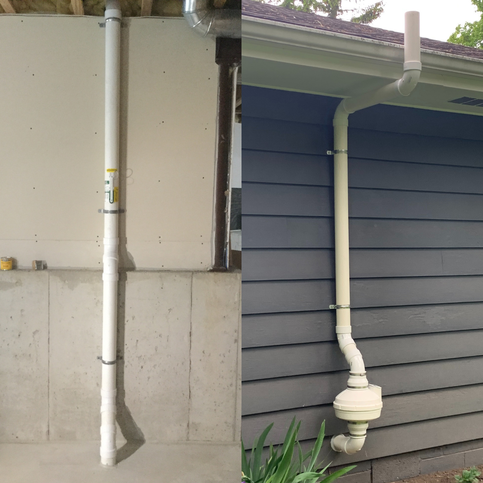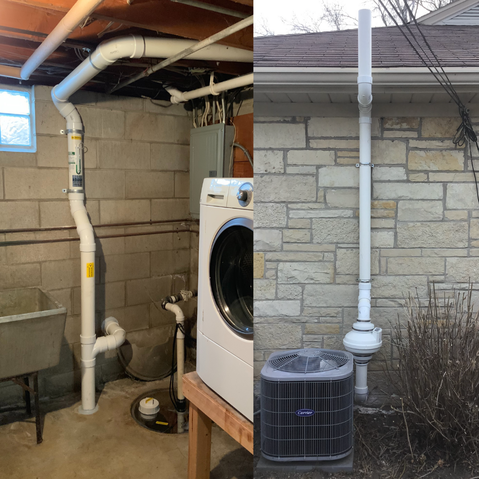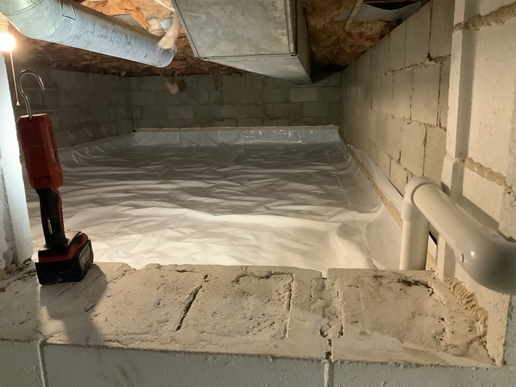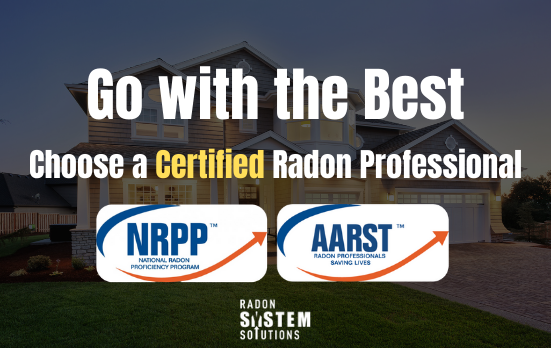Radon Mitigation Ashippun WI
|
|
What is Radon Mitigation?Well in short it is a venting system that is designed to divert rising soil gasses such as radon away from the home to dissipate into the outdoor air. To install a radon mitigation system into a home, all major cracks and holes in the basement need to be sealed to prevent radon gases from entering the living space and to ensure that the active system isn’t losing any pressure. A suction point is then determined (Radon systems can either use the sump crock or drain-tile to draw air out from under the home, or a collection point that is dug out from under the slab). Once the collection point is determined, a 3” or 4” PVC pipe is sealed to the floor and vented out of the home. A specialized radon mitigation fan is then placed on the piping to create the pressure needed to draw in the rising gasses, and the piping extends above the roofline to safely vent into the air and ultimately dissipate. Wisconsin is widely affected by radon, so if you live in Ashippun and have any questions or concerns please don’t hesitate to give us a call or click the link below to receive a free quote on a radon mitigation system.
|
Radon Mitigation SystemsBelow is a list of the types of radon mitigation systems we offer. If you do not see a style or option you are looking for, please contact us. Our technicians have over 30 years of combined experience and we can create custom radon mitigation systems for nearly any scenario.
|
Call Today! 262-599-6215
Radon Testing in Ashippun WI
Homes in Ashippun and throughout Racine County tend to have higher levels of radon. It is highly recommended that homes in Ashippun have a radon test done to determine if a radon mitigation system is needed.
Here are the types of radon tests we provide:
Here are the types of radon tests we provide:
Charcoal Testing Kits:
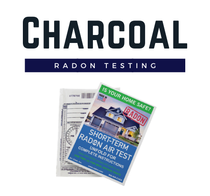
Charcoal radon test kits are a great option for homeowners who are not in the process of selling, and would like to know what their average radon levels are. Charcoal kits take 3-7 days to complete, and then are sent into a lab to be analyzed. Once the lab completes their analysis, they send out a report showing the average radon level during the period of time the kit was exposed. This is the most cost effective way to test your home for radon, and a great first step!
Digital Radon Testing Monitors:

Digital radon testing or professional radon testing, is the fastest and most accurate way to test your home for radon. We use the Airthings Corentium Pro testing monitor which can produce pinpoint accurate radon test results in as little as 48 hours. These types of radon tests are most commonly used in real estate transactions because of their accuracy, their quick turnaround, and “tamper proof” measures built into the software. If you have this test done on your home, you will receive a full report with an hour by hour reading, a temperature graph, a humidity graph, a tampering report, and an overall average. We recommend this option for real estate transactions and homeowners looking for the most accurate radon test available.
Long Term Radon Tests
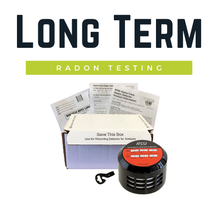
Long term radon test kits require a minimum of 91 days to complete but can be set for up to a full year. This is a good option for homeowners who are not in the process of selling their home and have done charcoal test kits in the past showing differing levels that were on the border of the EPA action level. A long average can be helpful to determine the true radon levels in a home for long periods of time as radon can fluctuate throughout the year.
For more information or to set up a radon test please give us a call or click the link below.
For more information or to set up a radon test please give us a call or click the link below.
Radon Mitigation Installation in Ashippun
If you’ve received your test results and the radon levels return at or above 4.0 pCi/L, it is strongly recommended by the EPA to install a radon mitigation system. A radon mitigation systems purpose is to lower the radon levels in your home and keep them at a safe level indefinitely. All homes in Ashippun have some level of radon. The EPA has stated that no level of radon is safe to live in for a long period of time. Being in the radon mitigation field for over 23-years, we have helped thousands of homeowners lower the levels of radon in their home to a safe level.
Our mitigation systems are all custom built to fit the style of your home. Give us a call for a free estimate!
Our mitigation systems are all custom built to fit the style of your home. Give us a call for a free estimate!
Sub-slab Depressurization:Sub-slab depressurization (SSD) is considered the most common and effective method of radon mitigation. To reduce the air pressure under the slab of the home, the radon system utilizes a fan to create a negative pressure, drawing air from below the slab, through the PVC piping, to ultimately vent above the roofline. The mitigation contractor will then typically seal all major cracks and gaps in the basement wall and floor and seal down the sump crock (if present in the home) with a see-through cover. For homes without a sump crock, we dig out around 5-10 gallons of material from under the slab to create a collection point and then draw the radon from this collection. Known to follow the path of least resistance, the radon gas is drawn through the piping and does not leak into the living space of your home.
|
Block Wall DepressurizationAnother way we mitigate radon in Ashippun is block wall depressurization. In short, this process uses a pipe inserted into the block cavity (in addition to the penetration into the slab or separate) and then the piping system is connected to a fan (on the exterior of the home) that draws the radon out from under your home. This method is recommended for homes with a block wall basement foundation and high levels of radon. By depressurizing the space within the concrete block, the radon is vented through the piping system. Many times, we use this method along with sub-slab depressurization.
|
Crawl Space DepressurizationThis radon mitigation process is many times necessary in homes that have a gravel or dirt crawl space. Since radon gas is derived from highly radioactive material in rock and soil, sealing the dirt or gravel crawlspace is sealing one of the largest entry ways for radon to enter your living area. These systems can become costly as the amount of materials and labor can increase the expense. However, the benefits of sealing the crawl space go beyond radon mitigation. With this method we use durable, cross laminated plastic sheeting, placing it over the ground of the crawl space and sealing it to the foundation walls. By connecting the piping under the sheeting, the fan then pulls the radon gas from under the sheet and vents it at least 6-12 inches above the roofline.
|
To get a quote for a radon mitigation system in Ashippun please give us a call or click the link below.
Radon Mitigation Companies Near Ashippun, WI
Whether you're buying, selling, or planning on living in a home for years to come, It is important to choose a reputable and certified radon company to install your radon mitigation system. Currently, in Wisconsin, it is not a requirement to hold certifications for radon mitigation or radon testing. Therefore, there may be organizations or individuals available for hire that actually may pose a great risk to your health, your home, and your property resale value.
|
The first thing you should do when calling around for radon mitigation estimates is ask if they are certified by the NRPP (National Radon Proficiency Program) or the NRSB (National Radon Safety Board). Certified companies are held to a higher standard for all radon mitigation installations, ensuring that you will receive a safe and effective system no matter what. Companies that do not follow these strict standards risk losing certification, so you can be sure that your system will be to code when you hire certified radon contractors. Our company is proudly certified by the NRPP and are members of AARST (American Association of Radon Scientists and Technologists) so we take pride in every install being perfect.
|
Frequently Asked Questions
What is Radon?
Radon is a naturally occurring radioactive soil gas that derives from the breakdown of uranium. Once formed, radon gas rises up from the soil to vent into the atmosphere to dissipate. If a home or commercial building is blocking its path, radon gas will become trapped and will find the path of least resistance into the structure. Once radon gas has entered the structure, it becomes trapped and starts to build up to unsafe levels as there is nowhere for it to dissipate. As radon decays it releases tiny radioactive particles called radon daughters which can attach to water vapor, dust, and smoke in the home. When these radioactive particles are inhaled over a long period of time they can damage the lining of our lungs and ultimately cause lung cancer.
Do Radon Systems Require Maintenance?
Fortunately, radon mitigation systems require very little maintenance by the homeowner. The only things homeowners need to do is keep an eye on the manometer (U-Tube) to ensure that the system is still pulling air from under the slab, and retest every two years or so to make sure everything is still working as it should. The radon fan should last at least 5 years at a minimum and can sometimes last up to 20 years. Once a radon fan has run its course, it can be replaced for a much lesser cost than installing an entirely new radon mitigation system.
Can Opening Windows Help Lower Your Radon Levels?
In some cases, opening windows can help ventilate the home and allow radon to escape. However, this is not a good long term solution to a radon issue. Unless you are willing to keep your basement windows open at all times during the year, you will not be able to consistently keep the radon levels in the home at a safe range. Additionally, you will be allowing the radon gas to enter the home first before letting it escape, so you will be exposed to that radon gas as it travels through the home. Unfortunately, some people will try to open windows during a radon test to skew the results lower for a home sale. Not only is this fraud, but in some cases this can cause the radon levels to increase inside of the home depending on the barometric pressure. It is never a good idea to intentionally mess with an active radon test.
Can I Install a Radon System Myself?
It is entirely possible for a homeowner to install a radon system in their own home, however it does require extensive knowledge of radon mitigation codes, construction processes, and standards. Radon mitigation system installations require tools that most homeowners do not have access to--so in the end, it may cost you close to the same amount that most companies would charge to do it for you. An improperly installed radon mitigation system can also cause a multitude of issues including carbon monoxide poisoning, an increase in radon levels, and fines from your municipality. Additionally, if certain codes aren’t followed, you may have to remove your DIY system upon selling you home, and hire a professional to install a brand new system, as most DIY systems cannot be salvaged.
Does the Radon Mitigation System have to Run out of the Sump Crock?
It is a common misconception that a radon mitigation system has to start out of the sump crock in a home. We can start the radon system pretty much anywhere in the basement as long as it is unfinished and can effectively generate enough negative pressure under the slab to draw the radon gas out. In situations where we do not use the sump pit as a collection point, we can simply seal the crock airtight (with a clear cover and clear silicone) and then core a hole into the floor about 9 ½ inches away from the wall (we know that by code, this is where the drain-tile should be). We can then attach the radon vent pipe directly to the drain-tile under the slab and the system will draw air through the drain-tile exactly how it would if it was coming directly out of the sump. For homes that do not have a sump crock and/or drain-tile under the slab, we simply core a hole into the slab and then remove 5-10 gallons worth of material to create a collection point and then run the system out of this “suction pit” style collection point. If you do in fact want the system to run directly out of the sump crock, we can certainly do that too!
About Us
|
We have been in business for over 23-years and installed thousands of radon mitigation systems. Further, we take pride in being Wisconsin’s premier radon mitigation company. We are certified for both radon testing and radon mitigation by the National Radon Proficiency Program and are members of the American Association of Radon Scientists and Technologists. We also have an entire commercial division certified in commercial radon mitigation, multi-family radon mitigation, vapor intrusion mitigation, and more.
We have a full office staff that are trained to give accurate and professional estimates, and we have some of the best warranties in the business. Even if you don’t live in Wisconsin, we are willing to answer any and every question you may have about radon because we truly believe in helping people. Give us a call today for a free radon mitigation quote, to schedule a radon test, or to ask us a question. We are here to help! |

